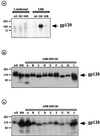Identification of gp120 regions targeted by a highly potent neutralizing antiserum elicited in a chimpanzee inoculated with a primary human immunodeficiency virus type 1 isolate
- PMID: 11000249
- PMCID: PMC112409
- DOI: 10.1128/jvi.74.20.9749-9754.2000
Identification of gp120 regions targeted by a highly potent neutralizing antiserum elicited in a chimpanzee inoculated with a primary human immunodeficiency virus type 1 isolate
Abstract
We have previously reported that a chimpanzee infected with a primary human immunodeficiency virus type 1 (HIV-1) isolate (HIV-1(DH12)) developed an extremely potent virus-neutralizing antibody. Immunoglobulin G purified from this animal conferred sterilizing immunity following passive transfer to macaques which were subsequently challenged with simian immunodeficiency virus/HIV-1 chimeric virus strain DH12. In addition to being highly strain specific, the chimpanzee antiserum did not bind to the V3 loop peptide of HIV-1(DH12), nor did it block the interaction of gp120 with the CD4 receptor. When neutralization was examined in the context of virus particles carrying chimeric envelope glycoproteins, the presence of all five hypervariable regions (V1 to V5) was required for optimal neutralization. Virions bearing chimeric gp120 containing the V1-V2 and V4 regions of HIV-1(DH12) could also be neutralized, but larger quantities of the chimpanzee antiserum were needed to block infection. These results indicate that the HIV-1 gp120 epitope(s) targeted by the chimpanzee antiserum is highly conformational, involving surface elements contributed by all of the hypervariable domains of the envelope glycoprotein.
Figures



References
-
- Albert J, Abrahamsson B, Nagy K, Aurelius E, Gaines H, Nystrom G, Fenyo E M. Rapid development of isolate-specific neutralizing antibodies after primary HIV-1 infection and consequent emergence of virus variants which resist neutralization by autologous sera. AIDS. 1990;4:107–112. - PubMed
-
- Bogers W M, Niphuis H, ten Haaft P, Laman J D, Koornstra W, Heeney J L. Protection from HIV-1 envelope-bearing chimeric simian immunodeficiency virus (SHIV) in rhesus macaques infected with attenuated SIV: consequences of challenge. AIDS. 1995;9:F13–F18. - PubMed
-
- Buchacher A, Predl R, Strutzenberger K, Steinfellner W, Trkola A, Purtscher M, Gruber G, Tauer C, Steindl F, Jungbauer A, et al. Generation of human monoclonal antibodies against HIV-1 proteins; electrofusion and Epstein-Barr virus transformation for peripheral blood lymphocyte immortalization. AIDS Res Hum Retrovir. 1994;10:359–369. - PubMed
MeSH terms
Substances
LinkOut - more resources
Full Text Sources
Other Literature Sources
Research Materials

